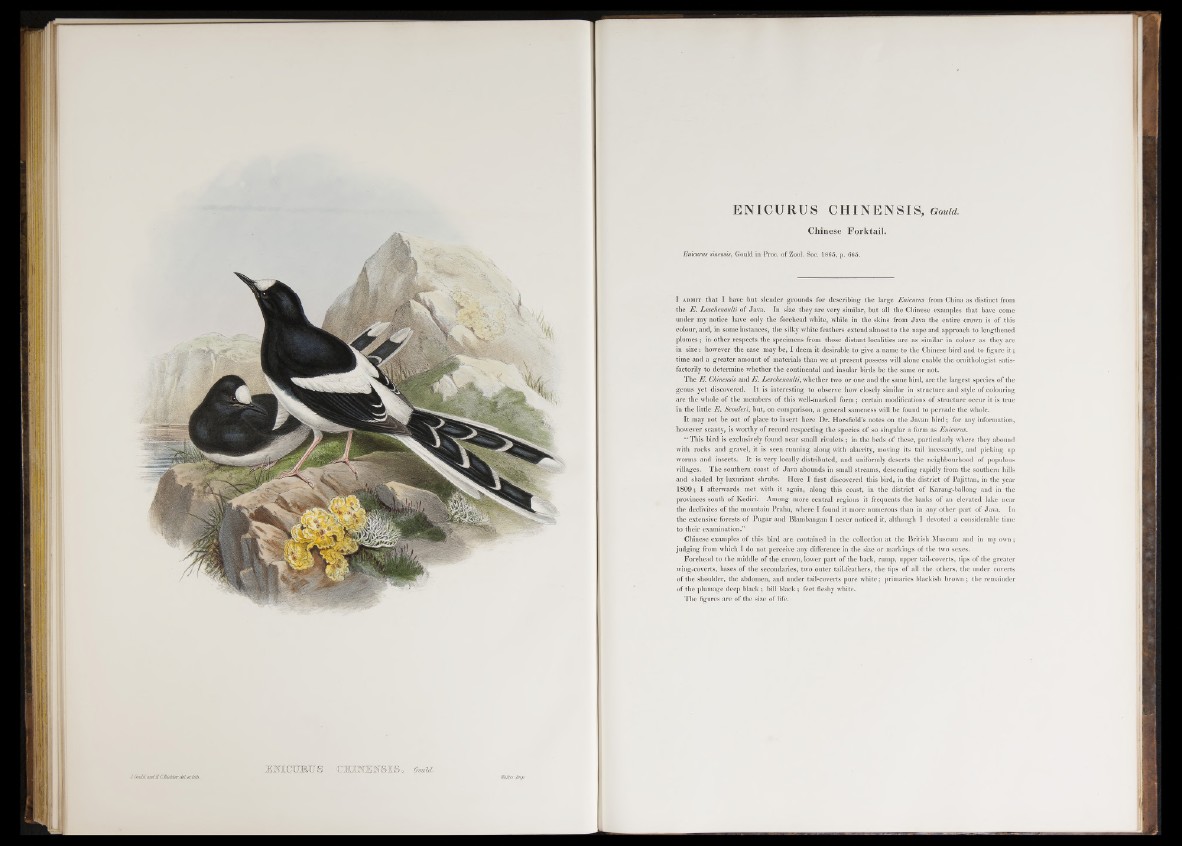
jEKICHRUS CHHOEirSIS. GrnU.
J.Gould.aniH. CJUchl/r. dtL. etjilh .
ENICURUS CHINENSIS, Gould.
Chinese Forktail.
Enicurus sinensis, Gould in Proc. of Zqol. Soc. 1865, p. 665.
I a dm it that I have but slender grounds for describing the large Enicurus from China as distinct from
the E . Leschenaulti of Java. In size they are very similar, but all the Chinese examples that have come
under my notice have only the forehead white, while in the skins from Java the entire crown is o f this
colour, and, in some instances, the silky white feathers extend almost to the nape and approach to lengthened
plumes; in other respects the specimens from those distant localities are as similar in colour as they are
in size: however the case may be, I deem it desirable to give a name to the Chinese bird and to figure i t ;
time and a greater amount of materials than we at present possess will alone enable the ornithologist satisfactorily
to determine whether the continental and insular birds be the same or not.
The E . C/iinensis and E . Leschenaulti, whether two or one and the same bird, are the largest species of the
genus yet discovered. It is interesting to observe how closely similar in structure and style o f colouring
are the whole o f the members of this well-marked form; certain modifications of structure occur it is true
in the little E . Scouleri, but, on comparison, a general sameness will be found to pervade the whole.
It may not be out o f place to insert here Dr. Horsfield’s notes on the Javan b ird ; for any information,
however scanty, is worthy of record respecting the species of so singular a form as Enicurus.
“ This bird is exclusively found near small rivulets; in the beds of these, particularly where they abound
with rocks and gravel, it is seen running along with alacrity, moving its tail incessantly, and picking up
worms and insects. I t is very locally distributed, and uniformly deserts the neighbourhood o f populous
villages. The southern coast of Java abounds in small streams, descending rapidly from the southern hills
and shaded by luxuriant shrubs. Here I first discovered this bird, in the district o f Pajittan, in the year
1809; I afterwards met with it again, along this coast, in the district o f Karang-ballong and in the
provinces south of Kediri. Among more central regions it frequents the banks o f an elevated lake near
the declivites of the mountain Prahu, where I found it more numerous than in any other part of Java. In
the extensive forests of Pugar and Blambangan I never noticed it, although I devoted a considerable time
to their examination.”
Chinese examples of this bird are contained in the collection a t the British Museum and in my own;
judging from which I do not perceive any difference in the size or markings of the two sexes.
Forehead to the middle of the crown, lower part of the back, rump, upper tail-coverts, tips of the greater
wing-coverts, bases of the secondaries, two outer tail-feathers, the tips of all the others, the under coverts
of the shoulder, the abdomen, and under tail-coverts pure white; primaries blackish brown; the remainder
of the plumage deep black ; bill black; feet fleshy white.
The figures are of the size of life.